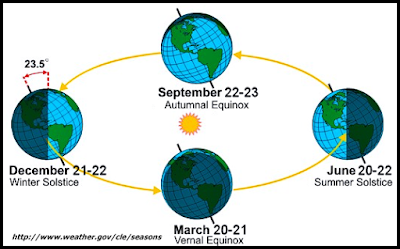The Solstices and The Equinoxes
The Solstices
The times when the Sun is at its furthest from the celestial equator are called the summer and winter solstices and these occur in mid-summer and mid-winter. The world 'solstice' comes from the Latin solstitium meaning 'Sun stands still' because the apparent movement of the Sun's path north or south stops before changing direction.
 |
| Figure: Equinoxes and solstices |
Summer Solstice:
On 21st of June the sun's rays are vertical over the Tropic of Cancer as the north pole of the Earth is inclined at its maximum towards the sun. At this time, the North Pole experiences a long continuous day and the South Pole a long continuous night (ergo, what we know as summer solstice). The northern hemisphere has the summer season at this time and the southern hemisphere experiences winter now. Also the days are longer than the nights in the northern hemisphere at this time.
Winter solstice:
Winter solstice:
On December 22, the position of the earth with respect to the sun is such that the South Pole is inclined at its maximum towards the sun and the Tropic of Capricorn receives the vertical rays of the sun. This position is called the winter solstice when the sun shines continuously in the South Polar Region and it is a long continuous night at the North Pole. This is the winter season in the northern hemisphere and the summer in the southern hemisphere. During the winter solstice, the days are longer than the nights in the southern hemisphere.
The Equinox
At the times when the Sun is crossing the celestial equator day and night are of nearly equal length at all latitudes and so we call these dates the equinoxes (which means 'equal night'). In March, as the Sun is moving northwards along the ecliptic, this is called the vernal equinox and in September as the Sun is moving southwards we refer to it as the autumnal equinox. The equinoxes are also the points on the celestial sphere where the ecliptic and equator cross and the vernal equinox is used as the zero point in measuring star co-ordinates.
- The equinoxes: On 21st March, the Earth is so positioned with reference to the sun that the sun's rays are vertical at the equator and the entire world experiences equal day and night.
- The autumnal equinox: A similar situation occurs on September 23.
 |
| Solstices and Equinoxes |

Comments
Post a Comment